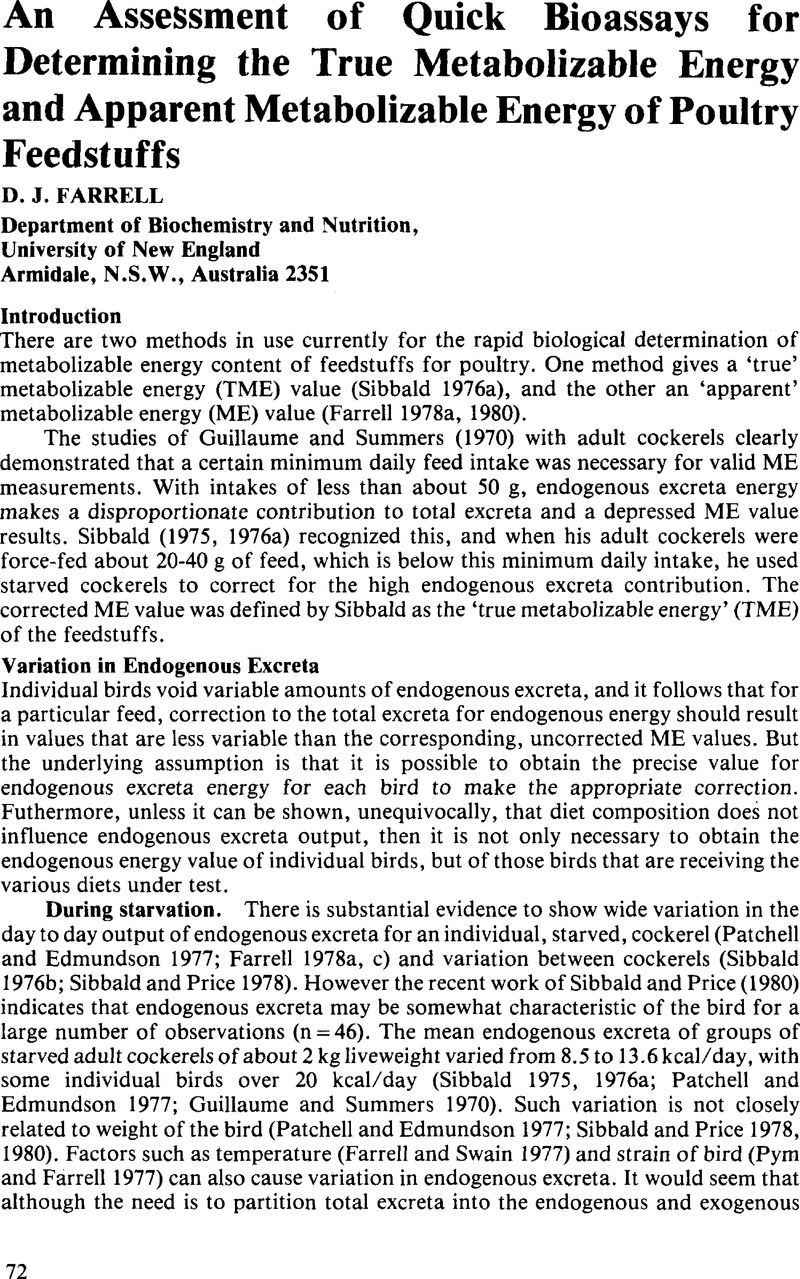Crossref Citations
This article has been cited by the following publications. This list is generated based on data provided by Crossref.
FISHER, C.
1982.
Recent Advances in Animal Nutrition.
p.
113.
Kussaibati, R.
Guillaume, J.
and
Leclercq, B.
1982.
The effects of age, dietary fat and bile salts, and feeding rate on apparent and true metabolisable energy values in chickens.
British Poultry Science,
Vol. 23,
Issue. 5,
p.
393.
SIBBALD, I.R.
and
MORSE, P.M.
1983.
The Effects of Feed Input and Excreta Collection Time on Estimates of Metabolic Plus Endogenous Energy Losses in the Bioassay for True Metabolizable Energy.
Poultry Science,
Vol. 62,
Issue. 1,
p.
68.
Van Kampen, M.
1983.
Effect of water : Food intake ratios in laying hens on food metabolisable energy.
British Poultry Science,
Vol. 24,
Issue. 2,
p.
169.
Mollah, Y.
Bryden, W. L.
Wallis, I. R.
Balnave, D.
and
Annison, E. F.
1983.
Sudies on low metabolisable energy wheats for poultry using conventional and rapid assay procedures and the effects of processing.
British Poultry Science,
Vol. 24,
Issue. 1,
p.
81.
Raharjo, Y.
and
Farrell, D.J.
1984.
A new biological method for determining amino acid digestibility in poultry feedstuffs using a simple cannula, and the influence of dietary fibre on endogenous amino acid output.
Animal Feed Science and Technology,
Vol. 12,
Issue. 1,
p.
29.
Pesti, G. M.
1984.
Influence of substitution method and of food intake on bioassays to determine metabolisable energy with chickens.
British Poultry Science,
Vol. 25,
Issue. 4,
p.
495.
du Preez, J. J.
Minnaar, A. du P.
and
Duckitt, J. S.
1984.
An Alternative Approach to a Compulsive Change from Conventional to Rapid Methods of Evaluating Metabolizable Energy.
World's Poultry Science Journal,
Vol. 40,
Issue. 2,
p.
121.
Wallis, I. R.
and
Balnave, D.
1984.
A comparison of amino acid digestibility bioassays for broilers.
British Poultry Science,
Vol. 25,
Issue. 3,
p.
389.
JANSSEN, W.M.M.A.
and
CARRÉ, B.
1985.
Recent Advances in Animal Nutrition.
p.
71.
Sibbald, I. R.
1985.
The True Metabolizable Energy Bioassay as a Method for Estimating Bioavailable Energy in Poultry Feedingstuffs.
World's Poultry Science Journal,
Vol. 41,
Issue. 3,
p.
179.
Wallis, I. R.
Mollah, Y.
and
Balnave, D.
1985.
Interactions between wheat and other dietary cereals with respect to metabolisable energy and digestible amino acids.
British Poultry Science,
Vol. 26,
Issue. 2,
p.
265.
MAIORINO, P.M.
AL-HOZAB, A.A.
MITCHELL, R.
and
REID, B.L.
1986.
Animal Fat Effects on Nutrient Utilization.
Poultry Science,
Vol. 65,
Issue. 12,
p.
2304.
FISHER, C.
and
McNAB, J.M.
1987.
Recent Advances in Animal Nutrition.
p.
3.
Bielorai, Rachel
and
Iosif, Bernard
1987.
Amino Acid Absorption and Endogenous Amino Acids in the Lower Ileum and Excreta of Chicks.
The Journal of Nutrition,
Vol. 117,
Issue. 8,
p.
1459.
McNab, J. M.
and
Blair, J. C.
1988.
Modified assay for true and apparent metabolisable energy based on tube feeding.
British Poultry Science,
Vol. 29,
Issue. 4,
p.
697.
Askbrant, S. U. S.
1988.
Metabolisable energy content of rapeseed meal, soyabean meal and white‐flowered peas determined with laying hens and adult cockerels.
British Poultry Science,
Vol. 29,
Issue. 3,
p.
445.
FISHER, C.
1989.
Recent Developments in Poultry Nutrition.
p.
27.
JANSSEN, W.M.M.A.
and
CARRÉ, B.
1989.
Recent Developments in Poultry Nutrition.
p.
78.
FISHER, C.
and
McNAB, J.M.
1989.
Recent Developments in Poultry Nutrition.
p.
54.



